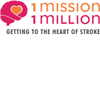Leading medical and patient organisations join forces to improve stroke prevention in atrial fibrillation
Posted: 18 April 2012 | | No comments yet
1 Mission 1 Million announces plans to launch an exciting new phase of the initiative…


1 Mission 1 Million – Getting to the Heart of Stroke announces plans to launch an exciting new phase of the initiative. Campaign sponsor Boehringer Ingelheim, in collaboration with AntiCoagulation Europe (ACE), the Atrial Fibrillation Association (AFA), the Stroke Alliance for Europe (SAFE) and the World Heart Federation (WHF), will continue to raise awareness of atrial fibrillation (AF) and its link to stroke, working hard to improve management of this condition. Community-based action is at the heart of this global initiative and during 2012 the campaign will continue to support projects around the world which aim to help prevent AF-related stroke.
“2012 will offer more opportunities for those working to prevent AF–related strokes”, said Dr Kathryn Taubert, Chief Science Officer for the World Heart Federation. “Many people are not fully aware of the increased risk of stroke associated with AF, despite it being the most common heart rhythm abnormality. 1 The World Heart Federation is proud to support 1 Mission 1 Million, an initiative which will continue to raise awareness and make a positive impact to those affected by this condition.”
As many as three million people worldwide have an AF-related stroke every year; equivalent to one person every 10 seconds. 2-5 One in four people aged 40 years or older develop AF, the most common sustained heart rhythm abnormality worldwide, during their lifetime. 1,6 In addition, AF-related strokes are more severe and are associated with more disability than non-atrial fibrillation strokes. 7,8
During World Heart Rhythm Week, 21-27 May 2012, 1 Mission 1 Million will reveal more details about their plans to support ongoing work in AF and additional planned activities taking place later this year. 1 Mission 1 Million will continue to support projects around the world which aim to help prevent AF-related stroke and is working with campaign supporters to determine how activities will be run in 2012. 1 Mission 1 Million further intends to provide a platform for patients, carers and all interested individuals to share their AF stories to inspire others to contribute to preventing AF- related stroke. A petition is also planned to unite people around the globe to support initiatives contributing to the aims of 1 Mission 1 Million.
“1 Mission 1 Million has already made a huge difference by funding AF-related stroke prevention projects and potentially saving many lives.” said Trudie Lobban MBE, Founder & Chief Executive Officer of the Atrial Fibrillation Association. “2012 represents another exciting year for the initiative as even bolder measures are taken to encourage action at both a community and global level. There will be many ways people can get involved and come together to ensure AF-related stroke prevention is recognised and managed effectively across the world.”
Thirty-two 1 Mission 1 Million winning projects across 18 different countries are currently being implemented to help prevent AF-related strokes. The projects received a share of €1 million in funding in 2011 and have been sending regular and encouraging updates on their progress. From these detailed reports, we estimate that so far more than 200,000 people are already directly benefitting from the ongoing work to help prevent AF-related strokes. This ranges from free ECG screenings, to radio and TV broadcasts, to large scale awareness events.
To benefit even more people this year, we want to encourage anyone who is involved in the management of AF, is affected by AF or simply has an interest in AF, to get involved with 1 Mission 1 Million. To join our mission, please contact the campaign organisers, [email protected].
For more information about 1 Mission 1 Million or to learn more about AF-related stroke, please visit www.heartofstroke.com.
References
- Stewart S, Murphy N, Walker A, et al. Cost of an emerging epidemic: an economic analysis of atrial fibrillation in the UK. Heart 2004; 90:286-92.
- Atlas of Heart Disease and Stroke, World Health Organization, September 2004. Viewed March 2011 at http://www.who.int/cardiovascular_diseases/en/cvd_atlas_15_burden_stroke.pdf
- Global Atlas on cardiovascular disease prevention and control. Viewed April 2012 http://www.world-heart-federation.org/publications/reports/global-atlas-on-cvd/
- Wolf PA, Abbott RD, Kannel WB. Atrial fibrillation as an independent risk factor for stroke: the Framingham Study. Stroke 1991; 22(8);983-8.
- Marini C, De Santis F, Sacco S, et al. Contribution of atrial fibrillation to incidence and outcome of ischaemic stroke: results from a population-based study. Stroke 2005; 36:1115-9.
- Lloyd-Jones DM, Wang TJ, Leip EP, et al. Lifetime risk for development of atrial fibrillation: the Framingham Heart Study. Circulation 2004; 110:1042-6.
- Lin HJ, Wolf PA, Kelly-Hayes M, et al. Stroke severity in atrial fibrillation: the Framingham study. Stroke 1996; 27:1760-4.
- Kelly-Hayes M, et al. The influence of gender and age on disability following ischemic stroke: The Framingham Study. J Stroke Carebrovasc Dis 2003; 12:119-26.
- Goodacre S, et al. ABC of clinical electrocardiography. Atrial arrhythmias. Br Med J 2002; 324:594-7.
- Kannel WB & Benjamin EF. Status of the epidemiology of atrial fibrillation. Med Clin North Am 2008;92:17-40.
- Hart GR, et al. Meta-analysis: Antithrombotic therapy to prevent stroke in patients who have nonvalvular atrial fibrillation. Ann Intern Med 2007; 146:857-867.




